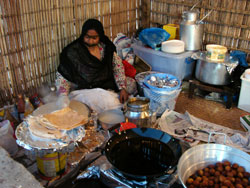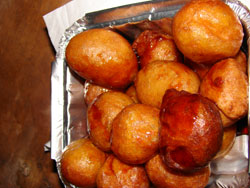What’s cooking in Dubai? Chabab and looqemat
This item appears on page 66 of the January 2010 issue.
by Sandra Scott
Dubai is considered an expensive destination, but it doesn’t have to be. My husband, John, and I visited Dubai in January ’09, and our favorite evening turned out to be our least expensive.
After wandering through the spice souk with its aromatic smells, we hopped on board an abra, handed the boatman one dirham (27¢) and crossed Dubai Creek. Abras are flat-bottomed water taxis that ferry people across the creek.
We strolled along the waterfront promenade for 15 minutes to the Sheikh Saeed al-Maktoum House, the 1896 home of an early ruler. Admission cost 50¢.
Interestingly, the house was kept cool by hanging wet cloths in the four wind towers. When the wind blew over the wet cloths, it caused evaporation — a cooling process.
After another 15-minute stroll we were at the Heritage Village, where admission was free. The living museum had a tented Bedouin village, camel rides, children performing traditional dances, weavers and an exhibition of traditional cooking techniques.
While I was asking the lady sitting on a rattan mat what she was cooking, a lady covered completely in a traditional black abaya and a veiled sheyla bought one of the crêpe-like items and wordlessly offered it to me. I graciously accepted. The cook was wearing a Gulf burqa, which in Dubai is a seldom-seen face covering of metallic-looking cloth.
I watched the cook pour batter on a flat frying pan, creating a chabab, or shebab, something similar to a crêpe. When it was cooked, she cracked an egg on top, spread it around and then did the same with the cream cheese.
Near her, another lady was deep-frying what looked like doughnut holes; these looqemats were slathered in syrup before serving.
John and I bought treats from both ladies for about one dollar each. We sat down to enjoy our “dinner” next to a man in a white kandura. He asked, “How do you like them? You will never find these in a restaurant, but my wife makes it all the time.”
We told him the food was great, as was our entire evening.
1½ cups milk
1 tbsp melted butter
Plus one egg and one wedge of cream cheese for each chabab
1 cup flour
pinch of salt
1 egg
1 egg yolk
Pour a thin layer evenly into a flat frying pan. Cook until the surface is dry and turn over. Break one egg on top and spread it quickly over the surface. Spread cream cheese over the top. After about a minute, fold it in quarters and serve.
Some recipes call for chopped onions, parsley and a variety of spices but not the ones we had in Dubai.
¼ ounce plain dried yeast
2½ cups lukewarm water
1 teaspoon sugar
3½ cups plain flour, sifted
corn oil (for frying)
juice of 1 large lemon
2 cups sugar
1 cup water


